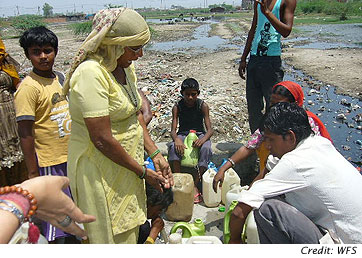
 NEW DELHI (WOMENSENEWS)–Thousands of women living in resettlement colonies on the fringes of this global city start the day by trudging to the nearest water standpipe or going through a narrow, muddy lane to queue up for a filthy community toilet.
NEW DELHI (WOMENSENEWS)–Thousands of women living in resettlement colonies on the fringes of this global city start the day by trudging to the nearest water standpipe or going through a narrow, muddy lane to queue up for a filthy community toilet.
It takes women in colonies such as Bawana and Bhalswa–formed by mass evictions of squatters from other parts of the city–an average 15 or 20 minutes to reach the convenience. Getting harassed by a male passerby can be a frequent part of the ritual.
A July study on women’s access to water and sanitation in Asian cities finds this kind of condition common for women living in urban poverty.
One young woman mentioned in the study is a 19-year-old identified only as Pooja. She lives in the colony Bhalswa and is affiliated with a local activist group.
"We get dirty water here, sometimes it’s brown like tea. Then, although there are 10 public toilet complexes in the 10 blocks in Bhalswa, only six work. It’s a big problem for us girls especially during menstruation," she says.
That’s just six working toilet complexes for Bhalswa’s 22,000 residents.
Sarita Baloni, a researcher with Jagori, a New Delhi women’s advocacy group, has been visiting Bawana, a settlement of over 130,000, for the past six years. She finds similar deprivation there.
"There are only 24 operational toilet complexes here. The standpipes initially installed by the government agencies don’t function. In most cases, the taps have been stolen. The water distributed is untreated ground water. None of the facilities have been designed or located in a manner that helps women’s access, especially if they are pregnant or very old," Baloni says.
Funding Disparities
The study was published jointly by Jagori and Women in Cities International, a global group with headquarters in Quebec, Canada. Funding support was provided by the International Development Research Centre, a Canadian support group for developing countries.
Researchers found major public funding disparities for water in and around New Delhi. Government funding inside the "jhuggi jhopri"– sprawling, mud-brick shantytowns–was about one-tenth the level of other places.
"These figures definitely point towards the priorities of the government," says Trisha Agarwala, research officer for the Centre for Budget and Governance Accountability, a partnering organization on the study. "Water and sanitation for the urban poor don’t seem to find favor."
Agarwala says the New Delhi budget allocates no special funding for women’s particular sanitation needs, even though the city planners have recognized women and children as being are more negatively affected by poor water and sanitation services than men. The government’s annual gender and budget statement makes no mention of water and sanitation.
"Whether it is the Women and Child Development Ministry or the Urban Development Ministry or the Rural Development Ministry, none of them includes water and sanitation in their gender budgets," says Agarwala.
Lost Time
 Researchers tried to calculate how much time and opportunity women lost as a result of poor infrastructure, given that women and girls are the ones primarily responsible for household water collection.
Researchers tried to calculate how much time and opportunity women lost as a result of poor infrastructure, given that women and girls are the ones primarily responsible for household water collection.
"We started by asking two questions: How much time does it take to access water and sanitation facilities; and whose time is it?" says Swapna Bist-Joshi, one of the study’s authors.
During field visits, women told Bist-Joshi that if they had better facilities, the time they’d save could be spent with their children or even looking for ways to supplement their meager family income.
Bist-Joshi says the government would be wise to invest in improvements.
"They would translate into economic gains through a productive work force. There will also be a lesser need to invest in health care because illness caused by bad water and dirty surroundings can be controlled. But the biggest gender argument is that if women’s lives are transformed, the lives of their families will automatically become better," she says.
In June, eight female community leaders in Bawana gathered signatures for a letter that outlined their local budgeting priorities, with better water and sanitation facilities at the top of the list.
The local politician in Bhalswa says more water pipelines are being laid. But if drains and roads are not also built, local women say they plan to add pressure about that too.
Would you like to Comment but not sure how? Visit our help page at https://womensenews.org/help-making-comments-womens-enews-stories.
Would you like to Send Along a Link of This Story?
https://womensenews.org/story/environment/110829/toilet-queue-starts-womens-day-in-delhi-slums
Aditi Bishnoi is an associate editor with the New Delhi-based Women’s Feature Service, the only features syndicate in India that produces articles with a gender perspective.
For more information:
Women’s Rights and Access to Water and Sanitation in Asian Cities (2009-2011):
http://jagori.org/wp-content/blogs.dir/46/files/2010/02/IDRC_Exec_summary.pdf
Jagori:
http://jagori.org/


